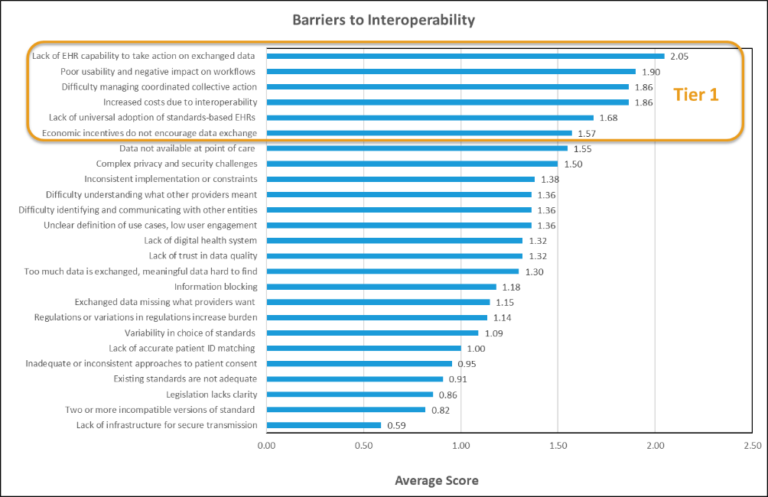ONC's Efforts to Advance Worldwide Digital Health - The Global Digital Health Partnership White Papers
 Aisha HasanAs the world responds to the COVID-19 pandemic, we continue to see how digital health plays a vital role in care delivery. ONC recognizes the importance of advancing digital health at domestic and global levels. As discussed in a previous blog post, part of ONC's global engagement includes representing the United States in the Global Digital Health Partnership (GDHP). The GDHP currently runs five work streams: Interoperability, Clinical and Consumer Engagement, Cyber Security, Evidence and Evaluation, and Policy Environments.
Aisha HasanAs the world responds to the COVID-19 pandemic, we continue to see how digital health plays a vital role in care delivery. ONC recognizes the importance of advancing digital health at domestic and global levels. As discussed in a previous blog post, part of ONC's global engagement includes representing the United States in the Global Digital Health Partnership (GDHP). The GDHP currently runs five work streams: Interoperability, Clinical and Consumer Engagement, Cyber Security, Evidence and Evaluation, and Policy Environments.
ONC Chairs the GDHP Interoperability Work Stream and within it we lead a variety of efforts to advance global digital health interoperability. This includes:
- A Global Master Standards Guide, a resource that identifies health data standards that nations should use for various digital health interoperability needs, and provides information on implementation specifications;
- A Global Interoperability Measurement Model, which is a policy and health data standards resource that identifies the interoperability adoption levels of GDHP nations; and
- Working with GDHP nations to advance the HL7 International Patient Summary (IPS), which is an electronic health record minimum dataset containing essential healthcare information intended for use in unscheduled, cross-border care scenarios. The IPS highlights the use case for interoperability regarding patients' health data being available across national borders to support patient care.
GDHP White Papers
The GDHP work streams published a series of white papers in 2019 that described the state of affairs of GDHP members' digital health. In 2020, the Partnership published a second series of white papers to advance digital health in the following work stream areas:
- Interoperability - Advancing Interoperability Together Globally is described below.
- Clinical and Consumer Engagement - Citizen Access to Health Data describes the impact of citizens accessing their health information.
- Cyber Security - Cyber Security: Foundational Capabilities depicts the necessity of establishing a unified cyber capabilities framework for health care.
- Evidence and Evaluation - Benefits Realisation: Sharing Insights offers a set of standards benefits categories and potential outcome measures.
- Policy Environments - AI for healthcare: Creating an international approach together describes policy recommendations on how nations can facilitate artificial intelligence-driven technologies in their health systems.
GDHP Interoperability Work Stream White Paper
Even though every nation has a different health care system, governance structure, and culture, all nations use health data standards. Countries and territories are at different stages of adoption and implementation of these health data standards, and the harmonization is crucial to promote the interoperability of health data across the globe. ONC's leadership as the GDHP Interoperability Work Stream Chair is just one part of our firm commitment to interoperability.
Advancing Interoperability Together Globally builds on the analysis in an earlier white paper, and identifies barriers to, purposes for, and drivers of interoperability of health information as a transformational challenge. It discusses the creative solutions that nations are taking to overcome interoperability challenges, and what the Interoperability Work Stream can do together to support adoption and use of health data standards.
Using detailed feedback from 22 nations on their interoperability efforts and the health data standards they use, the GDHP Interoperability Work Stream developed a health data standards crosswalk. While we understand the extent of usage of the full set of health data standards is more complex and nuanced than what is reflected, the crosswalk allows us to make initial, high-level comparisons about areas of common health data standards use.
Most GDHP nations support the International Statistical Classification of Diseases and Related Health Problems (ICD), SNOMED CT, Digital Imaging and Communications in Medicine (DICOM), Integrating the Healthcare Enterprise (IHE); Logical Observation Identifiers Names and Codes (LOINC); and Health Level 7 (HL7) V2, CDA, and HL7® FHIR®. We found that FHIR is key to several interoperability solutions that GDHP participants outlined in the white paper.
Data Responses
The white paper depicts GDHP nations' interoperability efforts from areas that inhibit or completely block interoperability, and areas that enable or support interoperability. We created a structured survey on interoperability for the GDHP participants' response. The key findings were grouped into 1) barriers to interoperability, and 2) purposes for interoperability.
The survey identified 25 barriers to interoperability, with the option for GDHP members to indicate additional barriers. This allowed us to better understand what the majority of GDHP nations are facing so we can develop efforts together that work to mitigate those barriers.
Purposes for Interoperability
Similar to the method for evaluating the barriers to interoperability, there were 11 purposes for interoperability that the nations identified in the survey:
- Transitions of Care
- Receiving Laboratory and Pathology Reports and Results
- Receiving Diagnostic Imaging Reports and Results
- Medication Management
- E-Prescribing of Medications
- Patient Access
- Referral Management
- Public Health Registries and Reporting
- Identifying Patients Accurately
- Clinical Ordering of Diagnostic Tests
- Clinical Ordering of Procedures
The GDHP participants also provided additional purposes for interoperability not listed in the survey.
The GDHP Interoperability Work Stream's efforts to identify common health data standards, barriers to interoperability, and purposes for interoperability in this white paper lay the foundation for collaborative pathways that can enhance our efforts on interoperability and health data standards use. ONC hopes that the GDHP's work continues to inform future health IT initiatives around the world and helps to increase coordination and collaboration on global harmonization of health data standards to help advance care delivery.
For more information about ONC's global health IT efforts, visit our recent blog post and the global health IT section of HealthIT.gov.
This post was published in HealthITBuzz, the blog of the Office of the National Coordinator for Health Information Technology (ONC). It is reprinted by Open Health News under public domain. The original post can be found here.
- Tags:
- Aisha Hasan
- barriers to interoperability
- CDA
- Citizen Access to Health Data
- Clinical and Consumer Engagement
- Clinical Ordering of Diagnostic Tests
- Clinical Ordering of Procedures
- COVID-19 pandemic
- cyber security
- digital health
- digital health interoperability
- Digital Imaging and Communications in Medicine (DICOM)
- E-Prescribing of Medications
- electronic health record minimum dataset
- essential healthcare information
- FHIR
- GDHP Interoperability Work Stream
- global digital health interoperability
- Global Digital Health Partnership (GDHP)
- Global Interoperability Measurement Model
- Global Master Standards Guide
- health data standards
- Health Level 7 (HL7)
- HealthITBuzz
- HL7 International Patient Summary (IPS)
- Identifying Patients Accurately
- information on implementation specifications
- Integrating the Healthcare Enterprise (IHE)
- International Statistical Classification of Diseases and Related Health Problems (ICD)
- interoperability
- interoperability adoption levels of GDHP nations
- interoperability of health data
- Logical Observation Identifiers Names and Codes (LOINC)
- medication management
- ONC's global engagement
- patient access
- Public Health Registries and Reporting
- Receiving Diagnostic Imaging Reports and Results
- Receiving Laboratory and Pathology Reports and Results
- referral management
- SNOMED CT
- transitions of care
- unscheduled cross-border care scenarios
- Login to post comments
